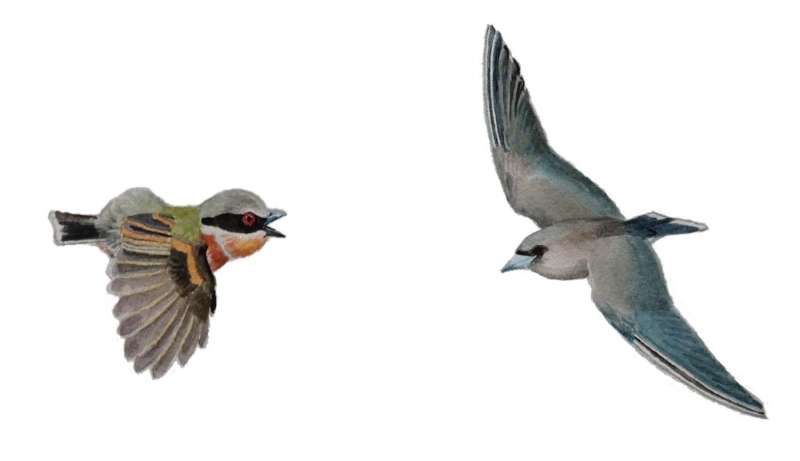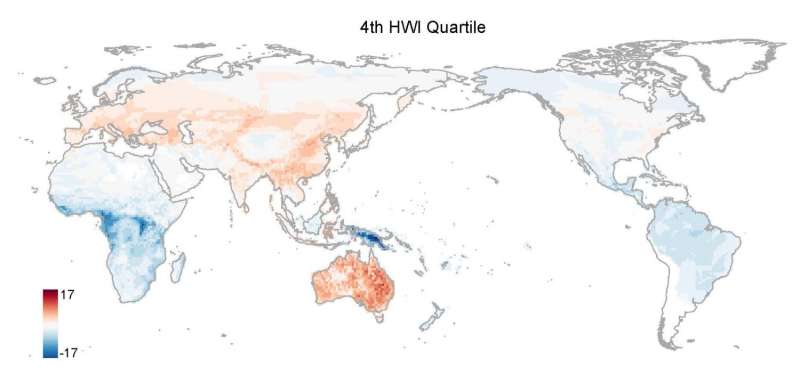The left bird, Dark batis (Batis crypta) has smaller round wings. The bird on the right, Dusky Woodswallow (Artamus cyanopterus), has long pointy wings evolved for long-distance flying. Credit: Jon Fjeldså
Bird's wings generally become shorter and more rounded the closer they live to the equator. Birds with smaller wings are to a greater extent restricted to stay in the same area, because their wings have not evolved for long distance travel. This new knowledge, published by scientists from the Center for Macroecology, Evolution and Climate, University of Copenhagen, helps us to better understand how life on Earth has developed.
"If only I had wings like a bird I could go anywhere in the world". This wish is shared among children throughout the Earth. But is it really so?
Scientists have discovered that the closer a bird lives to equator the shorter and more rounder its wings are. Short round wings have not evolved in order to aid travel over long distances, meaning these birds stay within a relatively restricted area throughout their life. First author and Post Doc Jonathan Kennedy from Center for Macroecology, Evolution and Climate, University of Copenhagen, explains:
"Although it might seem obvious that all birds are capable fliers because they have wings, our results challenge this assumption. Actually, birds that are found in different parts of the world have very different wing types. In many cases, birds will not fly longs-distances, unless their wings have specifically evolved for it. Our results provide new knowledge about how species spread across the world and improve our understanding of how life on earth has evolved."
Birds in the tropical rain forests of South America, Africa and New Guinea generally have smaller and more rounded wings compared to birds in temperate regions, like Europe or North America, whose wings tend to be longer and more pointed. The reason is that the wing shape reflects the bird's life style, Jonathan Kennedy elaborates"
"Some birds have long projected wings specially evolved to travel long distances. For example nomadic birds like the Dusky Woodswallow are able to fly numerous miles in order to find food. Other birds, like the sedentary Dark Batis, do not need to make long journeys in search of food, because it lives in tropical areas in which food is available year round. Instead, these birds have short and round wings developed to maneuver quickly between trees and bushes in the dense rainforest in which they occur."
Birds with longer and pointier wings dominate temperate areas, like Europe and North America (red). On the contrary, birds with smaller and more round wings are dominating in tropical areas, like South Africa and south America (Blue). Credit: Kennedy, et al, 2016.
The scientists behind the study have created the first global map to show the distribution of bird's across Earth as a result of their wing shape.
The map is based on measurements of 782 different kind of birds found across the globe. With the map, the scientists have been able to show that different wings types have had a big impact upon where bird species are found in the world, Jonathan Kennedy comments:
"Now we have finally shown what scientists have long suspected. A bird's wing plays a major role in determining where on Earth it is found. This knowledge gives us a solid foundation to better understand how bird species have spread across the Earth in search of food and places to live."
More information: The influence of wing morphology upon the dispersal, geographic distributions and diversification of the Corvides (Aves; Passeriformes), Proceedings of the Royal Society B, rspb.royalsocietypublishing.or … .1098/rspb.2016.1922
Journal information: Proceedings of the Royal Society B
Provided by University of Copenhagen
























